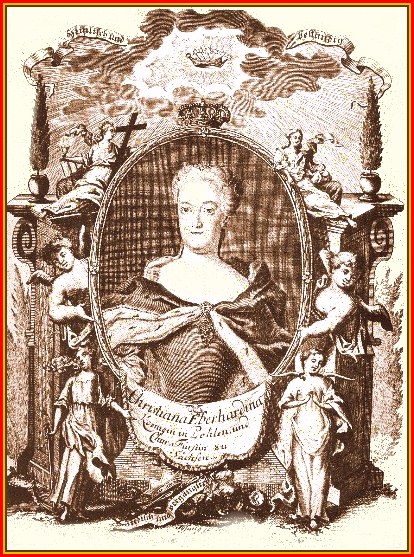|
Cantata 198: The TRAUER ODE for the Funeral of Queen Christiane Eberhardine of Poland/Saxony. Performed at a special Memorial Service held in the University Paulinerkirche, Leipzig, on October 17th, 1727.
the composition and performance of this Trauerode was probably the most significant to the composer, the performers and the citizens of Leipzig.
In 1697, Friedrich August, Elector of Saxony, assumed the Polish crown, which traditionally passed not through lineage, but on selection by the Polish nobility from eligible candidates. Extensive lobbying by the Saxon Court brought Friedrich August into the Finals, his main opponent being Louis, Prince of Conti. Stories are told of a midnight race from the Polish border to Krakov, then Polish capital. Friedrich August won and claimed the Crown. Louis, so it is said, consoled himself by making off with a substantial part of the Polish Crown Jewels.
In addition to the election competition there remained another challenge: the requirement that any king of Poland must be of Catholic faith. Despite the Elector's, and Saxony's solid Lutheran Protestant background, this was no problem for the opportunist Friedrich August who readily acceded, formally adopting Catholicism in Vienna on June 1st, 1697 despite a storm of protest from the strongly Protestant Saxon populace. Feelings were only slightly calmed by a formal announcement on July 27th that Protestantism in Saxony would in no way be jeopardized, as indeed it would not be. In fact the city of Dresden would be enriched by the juxtaposition of religious buildings of both faiths, often unofficially competing for prominence.
The death of Christiane Eberhardine was deeply mourned in strongly-Lutheran Saxony, and it was felt in Leipzig that some special memorial was required. Hans von Kirchbach, a nobleman student at the University of Leipzig, proposed a memorial service in the Paulinerkirche (University Church) during which he would deliver a valedictory address. Von Kirchbach commissioned a sometime librettist of Bach's, Johann Christoph Gottsched, to write verses for a Mourning Ode, and Bach to set these verses to music. The scoring of this work is extraordinary. A large and expressive grouping of instruments is used, including the usual complement of violins, violas, two flutes, two oboes and the usual continuo bass and harpsichord, together with a pair of those sweetly sorrowful instruments the oboes d'amore, two violas da gamba and two lutes. This pairing of so many highly contrasted and richly colored instruments is remarkable for Bach's time and must have occasioned considerable amazement and satisfaction, quite aside from the gratifying musical sound. The multiplicity of instruments also indicates the readiness, if not insistence, on the part of every capable musician in the city, to participate. According to the program, the Ode was "set by Herr Bach in the Italian style." Herr Bach conducted the performance from a clavicembalo, among the musicians in the gallery. The ceremony took place on October 17th, 1727. A great catafalque bearing the Queen's emblems stood in the center of the crowded church, and the service began with the ringing of all the bells of the city. The event was reported in Christoph Ernst Sicul's Das thränende Leipzig: "In solemn procession, while the bells were rung, the Town Officials and the Rector and Professors of the University entered St. Paul's, where many others were present, namely, princely and other persons of rank, as well as not only Saxon but also foreign Ministers, Court and other Chevaliers, along with many ladies. When everyone had taken his place, there had been a prelude by the organ, and the Ode of Mourning written by Magister Johann Christoph Gottsched, member of the Collegium Marianum, had been distributed among those present by the Beadles, there was shortly after heard the Music of Mourning, which this time Capellmeister Johann Sebastian Bach had composed in the Italian style, with Clave di Cembalo, which Mr. Bach himself played, also organ, violas di gamba, lutes, violins, recorders, transverse flutes, &c., half being heard before and half after the oration of praise and mourning." Bach's opening movement fittingly reflects the scene, with a tremendous and solemn chorus of great majesty for the entire choral and instrumental ensemble. The following recitative and aria use the color of the higher strings and the soprano voice for the expression of a noble grief. Then comes a remarkable example of pictorial expression, the tolling of the bells for the Queen. The ringing ceases by degrees, the final sound of the bass acting as cadence figure. An aria and recitative tell how bravely their Queen confronted death. A fugal chorus pays tribute to the Queen, here given the title of Glaubenspflegerin – Protector of the Faith. This concludes the First Part. At this point, Von Kirchbach delivered his Obituary Address. With the opening of the Second Part the pangs of death are conquered and the text is focused on the joy of the life hereafter. The Tenor aria, (8) sees the Queen now received in the "Sapphired Halls". The bass recitative extols her praises, with reference to the great rivers of Saxony and Poland, the Weichsel (Vistula), Dniester, the Elbe and Muth, as well as the Residence at Pretzsch on the Elbe to which the Queen had retired and nearby Torgau, where she spent time while Pretzsch was prepared. Notable is the absence of any reference to Dresden! In the peaceful, yet triumphant Final Chorus, her loyal citizens assure their Queen that she will live forever in their hearts.
Laß, Fürstin, laß noch einen Strahl Aus Salems Sterngewölben schießen. Und sieh, mit wieviel Tränengüssen Umringen wir dein Ehrenmal! Give one backward glance, O Princess, from Salem's starry Heaven, and see the wealth of tears we shed at thy Memorial.
2. Soprano Recitative
3. Soprano Aria
4. Alto Recitative
5. Alto Aria
6. Tenor Recitative
7. Chorus
8. Tenor Aria
9. Bass Recitative – Arioso - Recitative
10. Closing Chorus Note: When August I of Saxony became King of Poland, he was crowned August II, as there had already been an August I in Poland. The confusion continues when his son, August II of Saxony also becomes August III of Poland!
Baroque Music Page for a complete listing of all our Baroque Music sites.
|



